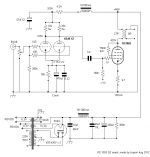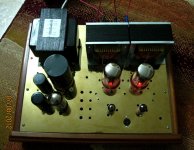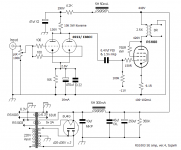Gain is set by is the relationship between R1 and R2.
About the rest, things have happened since -38. The pentode has finite gain an thus will not be pure I/V. There has been numerous threads here explaining this technique. Smokingamp, Wavebourn, Michael Koster, kenpeter and others have participated to shed light on this. Common knowledge I thought.
You can also Schade-connect a pentode like an anodefollower with the input feedback resistor being just above Zin. A triode can then be used as driver. Also check NP´s Zen also being a Schade design.
The most important is showed in fig 34 and 35 where you can see the characteristics going from pentode to triode when feedback is applied.
About the rest, things have happened since -38. The pentode has finite gain an thus will not be pure I/V. There has been numerous threads here explaining this technique. Smokingamp, Wavebourn, Michael Koster, kenpeter and others have participated to shed light on this. Common knowledge I thought.
You can also Schade-connect a pentode like an anodefollower with the input feedback resistor being just above Zin. A triode can then be used as driver. Also check NP´s Zen also being a Schade design.
The most important is showed in fig 34 and 35 where you can see the characteristics going from pentode to triode when feedback is applied.
here is my schema. 1st stage has gain 30, Zout about 1.3-1.4K.
sound is warm, great detail. bass becomes tight, controlled after 30 minutes of playing.
sound is warm, great detail. bass becomes tight, controlled after 30 minutes of playing.
An externally hosted image should be here but it was not working when we last tested it.
Last edited:
TC, I couldn't open your schematic, please post it on our server if you don't mind doing so.
RS1003 is a really good tube. I feel its sound seems like sound of my SV 811-10 on the midange and bass, but RS1003 is sweeter much
I don't know how to post a pictue on this server. here the link :
http://vnav.vn/forum/download/file.php?id=418835
http://vnav.vn/forum/download/file.php?id=418408
Last edited:
The links don't work for non members. To post attachments go to "Advanced" then manage attachments - at that point it should be obvious..
The links don't work for non members. To post attachments go to "Advanced" then manage attachments - at that point it should be obvious..
Ok, thanks kevinkr.
Attachments
Hi tcqanh,
Nice, simple design, can you estimate what sort of output power you are getting? The nice thing is that it appears that commonly available output transformers would be a good match based on your design choices.
What are you using for the -11V fixed bias supply? It seems like a 12V alkaline battery could be a good grid bias source if the 9.1 ohm cathode resistor were changed to 1 ohm. I used A23 type batteries to bias the 6V6 in a relatively recent SE amp, the holders are readily available from several eBay sellers along with the battery.
The amplifier itself looks very nice. 😀
Nice, simple design, can you estimate what sort of output power you are getting? The nice thing is that it appears that commonly available output transformers would be a good match based on your design choices.
What are you using for the -11V fixed bias supply? It seems like a 12V alkaline battery could be a good grid bias source if the 9.1 ohm cathode resistor were changed to 1 ohm. I used A23 type batteries to bias the 6V6 in a relatively recent SE amp, the holders are readily available from several eBay sellers along with the battery.
The amplifier itself looks very nice. 😀
Hi tcqanh,
Nice, simple design, can you estimate what sort of output power you are getting? The nice thing is that it appears that commonly available output transformers would be a good match based on your design choices.
What are you using for the -11V fixed bias supply? It seems like a 12V alkaline battery could be a good grid bias source if the 9.1 ohm cathode resistor were changed to 1 ohm. I used A23 type batteries to bias the 6V6 in a relatively recent SE amp, the holders are readily available from several eBay sellers along with the battery.
The amplifier itself looks very nice. 😀
this OPT is made for RS1003, so you can see it how big 🙂 and power get about 11-12W
I use 1 small power transformer for bias with simple circuit: bridge diode-RCRC- pot volume 15K. this negative bias voltage is not presented in my schema.
I never try bias with a battery. Could you show me its advantage ?
simple design,
for my opinion, the more simple circuit design is the better on sound quality. Negative feedback somewhat kills 2nd harmonic, so kill music too. Indeed, you can never see NF in my tube SE ampli 😀
for my opinion, the more simple circuit design is the better on sound quality. Negative feedback somewhat kills 2nd harmonic, so kill music too. Indeed, you can never see NF in my tube SE ampli 😀
I like very simple designs, mine generally are with a few exceptions.. I use no local or global feedback anywhere in the audio portion of my designs either and I would say for much the same reasons.
My power supplies tend to get somewhat complex, are tube based, generally regulated and obviously use feedback in such a case. (Low noise, low source impedance, relatively stiff and impervious to line born disturbances.)
WRT to the battery bias I am not sure it sounds any better than a very well filtered bias supply, but it is one of those silly things that amuses me these days so I do it. (See my Muscovite phono thread in analog source for how many batteries and chokes you can put in a phono stage. 😀 )
My power supplies tend to get somewhat complex, are tube based, generally regulated and obviously use feedback in such a case. (Low noise, low source impedance, relatively stiff and impervious to line born disturbances.)
Could you share how to get it ? any schematic ?
WRT to the battery bias I am not sure it sounds any better than a very well filtered bias supply, but it is one of those silly things that amuses me these days so I do it. (See my Muscovite phono thread in analog source for how many batteries and chokes you can put in a phono stage. 😀 )
Do you take a battery for gird bias in the 1st stage ? whith this, you can ignore a Ck (a bad Cka must worsen sound quality much).... so sound is maybe improved
 . For me, the lesser electric capacitor in the line of audio signal is the better.
. For me, the lesser electric capacitor in the line of audio signal is the better.Hi davorin,
Here's another plot: another plot.
Regards, Tom
Curves for triode connection RS1003 and SRS551 tubes (...)
Here's another plot: another plot.
Regards, Tom
- Status
- Not open for further replies.
- Home
- Amplifiers
- Tubes / Valves
- RS1003 in SE triode-UL monoblocks


